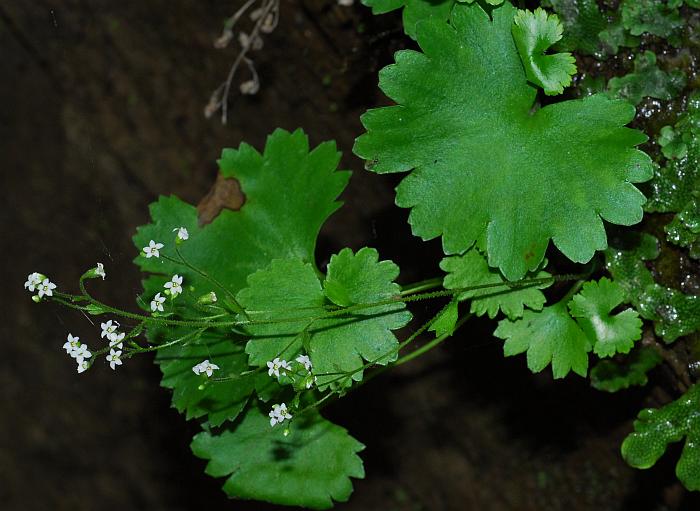Sullivantia sullivantii (Torr. & A. Gray) Britton
Sullivantia

Native
CC = 10
CW = 5
MOC = 7
SRank = S2
© SRTurner
Sullivantia sullivantii (Torr. & A. Gray) BrittonSullivantia | |
 |
Native CC = 10 CW = 5 MOC = 7 SRank = S2 |
© SRTurner |
|
Family - Saxifragaceae Leaves - Mostly basal, small leaves occasionally alternate along inflorescence axis. Basal leaves long-petiolate, with petioles glabrous or with a few stalked glands. Stipules 1-3 mm long. Basal leaf blades reniform to orbicular, cordate, with 7-13 shallow lobes, finely to coarsely toothed, palmately veined with 7-13 primary veins, glabrous, upper surface glossy.
Inflorescence - Open panicles to 30 cm long. Axis moderately to densely pubescent with stalked glands. Small linear to oblong bracts present at branch points.
Flowers - Flowers actinomorphic. Hypanthium bell-shaped, fused to about half the length of the ovary. Sepals 0.8-1.5 mm long, triangular-ovate to oblong-lanceolate, glabrous or with sparse stalked glands. Petals 1.5-3.5 mm long, glabrous, white. Stamens 5, slightly shorter than the calyx, the anthers small and yellow. Ovary 2-locular in the fused portion, the placentation axile. Styles tapered, the stigmas capitate.
Fruits - Capsules 3-7 mm long, narrowly ovoid to narrowly ellipsoid, 2-beaked, dehiscing longitudinally from each of the beaks. Seeds numerous, 0.7-1.2 mm long, narrowly oblong-elliptic in outline, somewhat flattened and narrowly winged, the surface smooth, tan to light brown.
Flowering - May - August. Habitat - Vertical, moist, north-facing canyon walls, on dolomite or sandstone substrate. Origin - Native to the U.S. Other info. - This small but easily recognized species is rare in Missouri, where it probably represents a glacial relict. It is not common anywhere within its range, which mostly consists of a few disjunct populations within the upper Midwest. Populations exist in localized and specialized microhabitats where cool, moist conditions are fairly constant throughout the year. Photographs taken at Don Robinson State Park, Jefferson County, MO, 5-24-2017, 6-7-2017, and 9-2-2021 (SRTurner). |